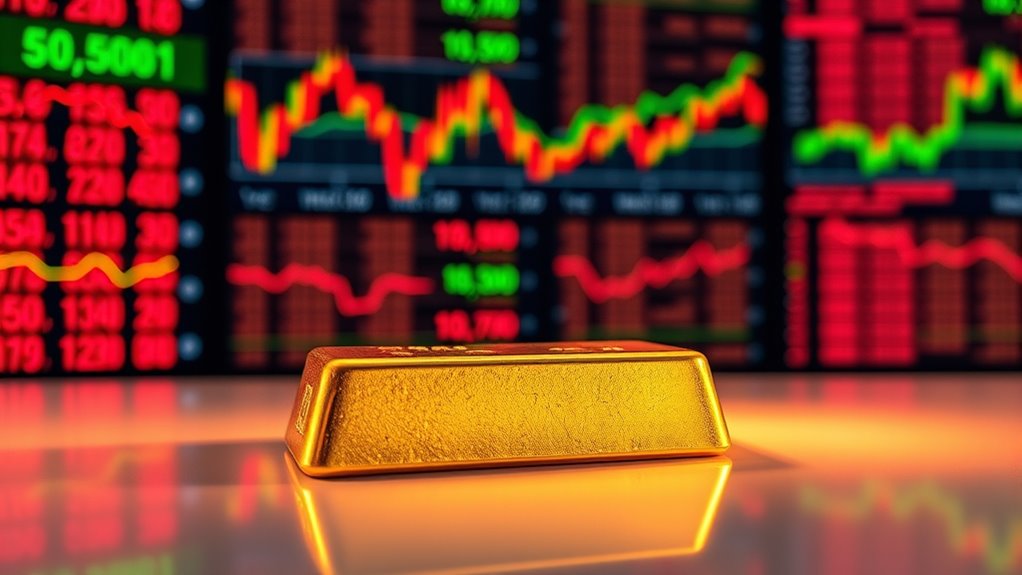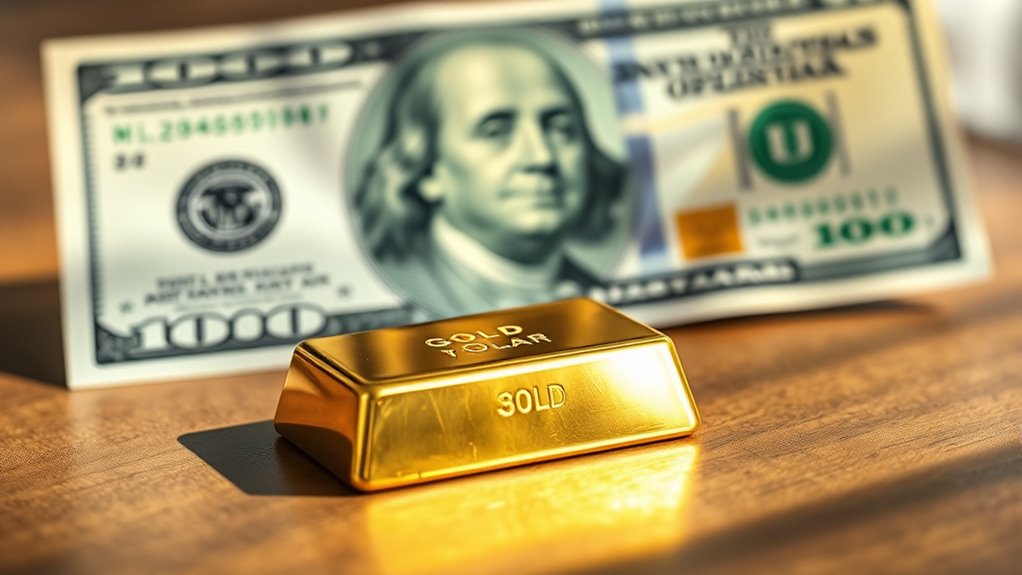When the dollar strengthens, gold prices tend to fall because gold is priced in dollars, making it more expensive for buyers elsewhere. A strong dollar signals economic confidence and higher interest rates, which can reduce appeal for non-yielding assets like gold. Conversely, a weaker dollar makes gold cheaper globally and often boosts demand, especially during inflation fears. To understand how currency shifts directly influence gold, keep exploring how these dynamics interact.
Key Takeaways
- A stronger USD often causes gold prices to decline due to higher gold costs for international buyers.
- A weaker USD typically leads to higher gold prices as gold becomes more affordable globally.
- USD strength reflects economic confidence, reducing investor interest in gold as a safe haven.
- An appreciating dollar can signal lower inflation expectations, decreasing gold’s appeal as an inflation hedge.
- Currency fluctuations influence investor sentiment, with a strong USD diminishing gold demand and vice versa.

The strength of the U.S. dollar has a direct and significant impact on gold prices, often moving in opposite directions. When the dollar appreciates, gold tends to decline, and when the dollar weakens, gold usually rises. This inverse relationship stems from the concept of currency correlation, where gold acts as a global currency and an alternative store of value. Because gold is priced in dollars worldwide, a stronger dollar makes gold more expensive for buyers using other currencies, reducing demand and pushing prices down. Conversely, a weaker dollar makes gold more affordable globally, boosting demand and raising prices. Additionally, gold’s role as an inflation hedge becomes more prominent during periods of dollar weakness, as investors seek assets that preserve value amidst rising inflation. When the dollar weakens due to inflationary pressures, investors seek assets that preserve value, and gold becomes an attractive option. During periods of rising inflation, the dollar’s purchasing power declines, so people turn to gold to protect their savings. This dynamic emphasizes how currency fluctuations directly influence gold’s role as an inflation hedge. When inflation expectations increase, gold prices tend to climb as investors look for safe havens that retain value amidst declining dollar strength. Understanding this relationship helps you anticipate gold price movements based on currency trends. For example, if you notice the dollar gaining strength due to favorable economic data or rising interest rates, you might expect gold prices to decline. Conversely, if geopolitical tensions or economic uncertainties weaken the dollar, gold could become more appealing, leading to price increases. The currency correlation underscores the interconnectedness of global markets, and tracking dollar movements gives you insight into gold’s short-term and long-term trends. Moreover, shifts in the dollar’s strength impact gold not just through direct demand but also through investor sentiment. When the dollar weakens, it often signals concerns about economic stability or rising inflation, encouraging investors to buy gold for protection. On the other hand, a robust dollar can indicate confidence in the U.S. economy, reducing the perceived need for gold as a safe haven. This relationship makes understanding dollar movements crucial for anyone looking to enter or exit the gold market strategically.
Frequently Asked Questions
How Does Currency Inflation Impact Gold Prices?
When currency inflation occurs, you’ll see gold prices typically rise because currency devaluation makes gold more attractive as a store of value. As inflation expectations grow, investors seek gold to hedge against declining purchasing power. This increased demand pushes gold prices higher. So, inflation expectations and currency devaluation directly influence gold, making it a go-to safe haven during periods of currency inflation.
What Role Do Geopolitical Events Play in USD Strength?
Like a puppet master pulling strings, geopolitical events influence USD strength by shaping perceptions of economic sanctions and political stability. When tensions rise, investors seek the dollar’s safety, strengthening it. Conversely, peace and stability weaken the dollar. You can see how crises or conflicts trigger these shifts, impacting gold prices. Geopolitical risks, thus, serve as catalysts, making the dollar a barometer of global stability and directly affecting gold’s value.
Can Gold Serve as a Hedge Against Dollar Decline?
Yes, gold can serve as a hedge against dollar decline. When the dollar weakens, gold prices typically rise, helping you diversify your investments and protect against currency devaluation. By including gold in your portfolio, you reduce reliance on the dollar and mitigate risks associated with currency fluctuations. This diversification can preserve your wealth during periods of dollar weakness, making gold a valuable tool in your financial strategy.
How Do Interest Rate Changes Affect Gold and USD?
Think of interest rate changes as a tug-of-war between currency reserves and trade deficits. When rates rise, the USD becomes a strong anchor, attracting investors and lifting the dollar’s value. This often drives gold prices down, as it’s less attractive as an alternative investment. Conversely, lower rates weaken the dollar, making gold more appealing, especially if trade deficits grow, prompting you to contemplate gold as a hedge.
What Is the Long-Term Relationship Between USD and Gold?
You’ll find that in the long term, a strong USD signals US economic stability and maintains its status as the global reserve currency. This often leads to lower gold prices because investors prefer the dollar over gold as a safe haven. Conversely, when US economic stability weakens or the USD reserve status is questioned, gold prices tend to rise, reflecting increased demand for a reliable store of value.
Conclusion
As you watch the dollar’s strength ebb and flow like tides, remember how it pulls gold’s shimmer along with it. When the dollar rises, gold’s gleam dims, hiding beneath the shadow of economic shifts. But when the dollar softens, gold’s radiant glow reemerges, inviting you to seize the moment. Stay tuned to this dance—it’s a rhythm that can turn your investments into a shining beacon or a fleeting shadow in the vast financial sky.









